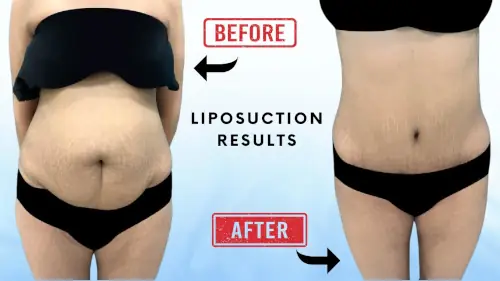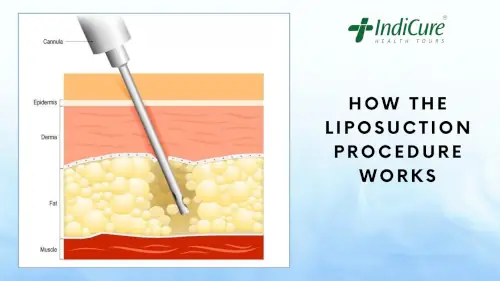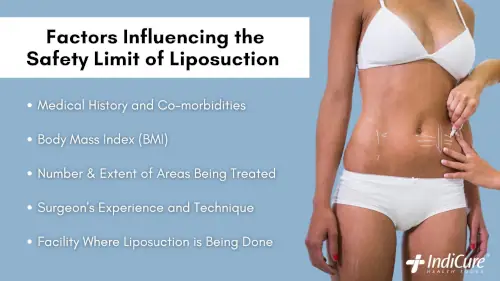How Much Liposuction Is Safe in One Go? Balancing Aesthetics and Safety

Liposuction: Introduction
Liposuction, one of the most popular plastic surgery procedures in the world, has given men and women of all ages the freedom to reshape their bodies and a boost to their confidence. According to statistics from the American Society of Plastic Surgery, liposuction continues to hold the top position among plastic surgery procedures, not only in the United States but across the globe in 2024 as well.
The procedure saw a massive 7% increase in several people opting for it over the previous year. Talking in numbers, around 350,000 people underwent liposuction in the United States alone, and 2.3 million underwent liposuction worldwide in 2024.
What is Liposuction?
Liposuction is a minimally invasive procedure that works by removing stubborn fat deposits from a particular area. While many people do confuse it as a weight loss procedure, liposuction is not a technique to lose weight. Liposuction promises to remove stubborn fat that doesn't go away with diet and exercise and bring that particular area into shape.

However, in the pursuit of aesthetic enhancement, one must not forget the paramount concern: Patient Safety. Determining how much liposuction is safe in one go can be challenging, as the decision is heavily influenced by established medical guidelines and individual factors.
This article intends to present a thorough summary of guidelines governing safe liposuction, risks of excessive fat removal, factors that affect the limit of fat that can be removed, pre- and post-op care, and the crucial role of the surgeon's expertise in ensuring safety while performing liposuction.
The Tight Rope Walk: Navigating Safety and Results
Before we dive deep into the topic, let us first understand the process of liposuction. How is Liposuction Done? Let's have a look at the most important steps in performing liposuction.
Pre-Op Preparation:
After a thorough consultation and examination by the surgeon, the area to be treated is marked. The procedure is either performed under general anesthesia or local anesthesia with sedation, depending on how big an area is to be treated and your and your surgeon's preference.
Procedure
There are various techniques of liposuction, such as laser liposuction, water jet liposuction, tumescent liposuction, etc. Here is the step-by-step process for the most common tumescent liposuction technique:

- Tumescent Fluid Injection- The targeted area is injected with a sterile solution that contains saline, a local anesthetic (such as lidocaine), and epinephrine, which constricts blood vessels. This solution lessens bleeding and makes the fatty tissue simpler to work with by making it firmer and swollen.
- Incision and Cannula Insertion- Small incisions, of the size ¼ to ½ inch, are made in the skin through which a small tube called a cannula is inserted.
- Fat removal- The surgeon moves the cannula in a controlled back-and-forth motion to loosen the fat and suctions it out using a vacuum connected with the cannula.
While it seems simple and easy, let us understand the physiological impact of liposuction on our body.
Understanding the Physiological Impact of Liposuction
The removal of fat also involves loss of fluids and electrolytes from the body, and also disruption of blood vessels to an extent. The process sets off a series of physiological actions in the body, which include fluid balance, hormonal fluctuations, and inflammatory reactions. And the extent of these physiological changes is in direct proportion to the volume of aspirate removed from the body.
It is also worthwhile to note that this aspirate is not only fat, but it is a mixture of adipose tissue, blood, and the tumescent fluid. And the more the fat is removed, your body tends to lose blood and fluids, triggering more changes in the body.
Risks of Large Volume Liposuction
Several potential problems can arise from exceeding safe liposuction volumes, and some of them can be fatal, making it mandatory to assess how much liposuction is safe in one go.
Some of the major risks of large volume liposuction are:

The 5-Liter Rule of Liposuction
The American Society of Plastic Surgeons (ASPS) has laid out a guideline that recommends a maximum of 5 litres of aspirate removal while performing liposuction. This guideline serves as a valuable starting point in assisting plastic surgeons to mitigate any chances of complications. However, it is important to note that this is not an absolute, universally applicable rule.
The 5-litre rule is an effort to strike a balance between patient safety and aesthetic results that the procedure aims to achieve. The rule highlights that higher volumes of liposuction carry higher risks of complications.
"However, the tolerance is greatly influenced by the patient's unique characteristics," says Dr Shraddha Deshpande, a renowned plastic surgeon in Mumbai with many years of experience in performing large volume liposuctions. "We assess each patient thoroughly on various parameters mentioned below and do a careful analysis about how much liposuction is safe for him/her and then proceed with the surgery", she adds.
Personalised Approach to Safe Liposuction Volumes:
Some of the factors that influence the safety limit of liposuction in each patient include:

- Medical History and Co-morbidities: In patients with pre-existing medical conditions such as cardiac problems, autoimmune disorders, bleeding disorders, etc, or co-morbidities like diabetes, hypertension, etc., large volume liposuction is fraught with risks. The surgeons are usually very conservative while performing the procedure and are highly careful in monitoring when liposuction is done in such patients.
- Body Mass Index (BMI): While it may sound like the patients with higher BMI have higher tolerance limits, this is far from the truth. High BMI patients are not good candidates for large volume liposuction, or liposuction at all. This is because people with high BMI are more at risk of wound healing problems, blood clots, and infections. Besides, liposuction is a tool to contour a specific area of the body and is not meant for weight loss.
- Number & Extent of Areas Being Treated: How many areas are treated in one go, and how big the area is, influences the volume of liposuction that is safe in one go. For example, if chin liposuction is being done with arms, the surgeon can be aggressive with the liposuction. However, if the area being treated is 360-degree abdominal liposuction with thighs, one needs to be conservative in removing fat from a particular area, as treating multiple areas in one go increases the risk of fluid shifts and other complications.
- Surgeon's Experience and Technique: A skilled and experienced surgeon can minimize trauma, blood loss, and fluid shifts, potentially allowing for slightly higher volumes in select cases. However, for a skilled and experienced surgeon, your safety always remains the top priority.
- Facility where liposuction is being done: Whether the procedure is being done in an office setting, or a big hospital with emergency care/ICU setting, gives the surgeon a good deal of choice in determining the extent to which liposuction can be done in one go. It is often observed, given all other parameters remain constant, that a surgeon tends to be much more conservative if the procedure is done in an office setting rather than a big hospital.
As mentioned by Dr Shradha Deshpande above, the patient's medical history and a thorough pre-op evaluation lays the foundation for how much liposuction is safe in one go, ensuring patient safety and helping minimize the risks.
The evaluation includes:
- Physical Examination: This includes examination of the areas where liposuction needs to be done, overall health of the patient, and assessment of skin elasticity of the area(s). If the skin elasticity is poor, the surgeon may have to add skin removal with liposuction to avoid loose or hanging skin after the surgery. It is imperative to understand and discuss the goals and expectations of the patient from the procedure. This ensures the patient doesn't have unrealistic expectations or misconceptions about the procedure.
- Review of Medical History: A thorough review of the patient's medical history, any surgeries done in the past, medications the patient is taking, any pre-existing conditions, co-morbidities, allergies etc, is important to assess the candidacy. The patient needs to be physically, emotionally, and mentally fit and stable to undergo the surgery.
- Pre-Op Investigations: Before any surgery or anaesthesia, the patient needs to be thoroughly assessed to see if he/she is fit to undergo surgery and general anaesthesia. This includes blood tests- thyroid function tests, blood counts, kidney, liver, and lung function tests, ECG, echocardiography- if the patient is above 50, coagulation studies, etc. This ensures the complete safety of the patient and a smooth recovery.
- Careful Planning: After all of the above, the surgeon must carefully plan the procedure, considering the areas to be treated, the estimated volume of fat removal, and the patient's characteristics. This allows the surgeon to assess how much fat can be removed safely in one go and what kind of results can be expected.
Post Operative Care for Liposuction
The post-operative care after liposuction plays as important a role in safety and minimizing the risks or complications as pre-operative care. Some of the factors that aid healing and are standard guidelines after liposuction are wearing a compression garment for a few weeks after the surgery, avoiding lifting heavy weights or strenuous activities for 2-4 weeks, and following proper hygiene/ wound care instructions to prevent infection.
Compression garment reduces swelling and minimize bruising by evenly applying gentle pressure in that area. Because liposuction can result in fluid buildup, applying pressure greatly reduces swelling and bruising.
The compression garment also promotes skin retraction after liposuction, thus enhancing the results. Pain management, hydration, adequate movement and activity, and regular follow-ups with the surgeon are other important things to follow, to enhance safety after liposuction.
The Role of Surgeon's Expertise in Ensuring Safe Liposuction
The plastic surgeon's expertise and ethical considerations play a critical role in ensuring patient safety. Here's how a board-certified plastic surgeon with extensive experience in performing liposuction can make a difference:
- Choosing the Right Candidate- A qualified and experienced surgeon chooses only the right candidate for liposuction and not anyone who just wants to sign up for the procedure. The right candidate for liposuction is close to his/her ideal BMI and not too overweight; seeking liposuction for contouring a specific body part and not as a weight loss solution; is physically healthy, mentally and emotionally stable; is not suffering from any serious medical ailments, and has realistic expectations from the procedure.
- Preparing a Personalized Treatment Plan- The surgeon draws a personalized treatment plan according to the patient's specific health condition and requirements. A good plastic surgeon would calculate how much fat can be safely removed in one go without jeopardizing the safety well before starting the procedure and stick to it.
- Performing the Procedure Meticulously- A skilled surgeon removes fat strategically to avoid irregularities, asymmetry, or excessive fat removal, which can cause contour deformities.
- Post-Operative Care- While many patients feel that this is not important, comprehensive post-op care goes a long way in ensuring safety after liposuction and bringing out the best results from the procedure. Any minor complication that is immediately dealt with ensures the patient is safe and gets the best results from the procedure.
A qualified and renowned plastic surgeon prioritizes patient safety above all else. Of course, the results are important and the patient pays for getting the best results; the trade-off remains, and a board-certified surgeon knows how to balance that.
The Last Word: Balancing Aesthetics and Safety
A careful balance between patient safety and aesthetic objectives is necessary for safe liposuction. Minimizing risks and attaining the best results require thorough pre-operative evaluations, adherence to established guidelines, and comprehensive post-operative care.
Although the 5-liter recommendation is a useful tool, patient-specific circumstances must always be taken into account. A board-certified plastic surgeon should always be consulted by patients to know their options and make sure the surgery is carried out in a way that is both ethical and safe. When it comes to cosmetic surgery, patient safety must always come first.
It is crucial to take ethics into account. Surgeons should refrain from exceeding safe volume limitations to accomplish irrational aesthetic objectives. They must put the health of their patients first and give them truthful, correct information regarding the advantages and disadvantages of liposuction and how much liposuction is safe in one go in their specific case.
About IndiCure Health Tours
IndiCure Health Tours is the most renowned company offering plastic surgery in India in association with some of the best board-certified plastic surgeons in India. With an experience of 15 years in delighting medical tourists from across the world, IndiCure ensures that your safety and well-being are of paramount importance and that they are never compromised.
So, if you are wondering how much liposuction is safe in one go for you, you can write to us at info@indicure.com or call/WhatsApp us at +91 93200 36777 for a free evaluation about your procedure from some of the best plastic surgeons in India.